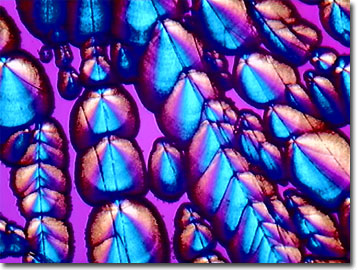Polarized Light Digital Image Gallery
Pantothenic Acid
Pantothenic acid, a B-complex vitamin, is essential for growth, reproduction and normal metabolic processes in humans and other animals. Common dietary sources of pantothenic acid are yogurt, lentils, eggs, liver, meats, lobster, avocado, mushrooms, sweet potato, soybeans, brewer's yeast, and wheat germ.

Pantothenic acid was discovered in 1919 and isolated from yeast by Dr. Roger J. Williams in 1933. Its name is derived from the Greek word pantothen that means "from everywhere", which is appropriate for this widely distributed vitamin. Pantothenic acid is an integral part of coenzyme A and plays the important role of decarboxylating pyruvate in the citric acid cycle. Clinically, pantothenic acid is necessary for the synthesis of red blood cells, steroid metabolism, neuron activity, and stimulation of antibody production. Because of its ubiquitous nature, pantothenic acid deficiency is very rare unless specifically engineered for the purposes of biochemical investigations, or as an unwanted side-effect from another pharmaceutical, such as pantoyl-GABA, used widely in Japan as an antidementia drug. While stable in a neutral solution, processing food items with heat in either alkali or acid results in significant panothenate loss and destruction.
Synthetic pantothenic acid is marketed as a calcium salt for industrial manufacturing and organic chemical processes, as well as a major nutrient component of animal feeds. As a dietary supplement and in cosmetics, panothenate is supposed to prevent premature aging and wrinkling. Because pantothenic acid is one of the B-complex vitamins, it is water soluble, meaning that any excess is eliminated via urine and sweat and must be replenished on a daily basis.
Contributing Authors
Omar Alvarado, Thomas J. Fellers and Michael W. Davidson - National High Magnetic Field Laboratory, 1800 East Paul Dirac Dr., The Florida State University, Tallahassee, Florida, 32310.
BACK TO THE POLARIZED LIGHT IMAGE GALLERY
BACK TO THE DIGITAL IMAGE GALLERIES
Questions or comments? Send us an email.
© 1995-2025 by Michael W. Davidson and The Florida State University. All Rights Reserved. No images, graphics, software, scripts, or applets may be reproduced or used in any manner without permission from the copyright holders. Use of this website means you agree to all of the Legal Terms and Conditions set forth by the owners.
This website is maintained by our
Graphics & Web Programming Team
in collaboration with Optical Microscopy at the
National High Magnetic Field Laboratory.
Last Modification Friday, Nov 13, 2015 at 01:19 PM
Access Count Since September 17, 2002: 12720
Visit the website of our partner in introductory microscopy education:
|
|
